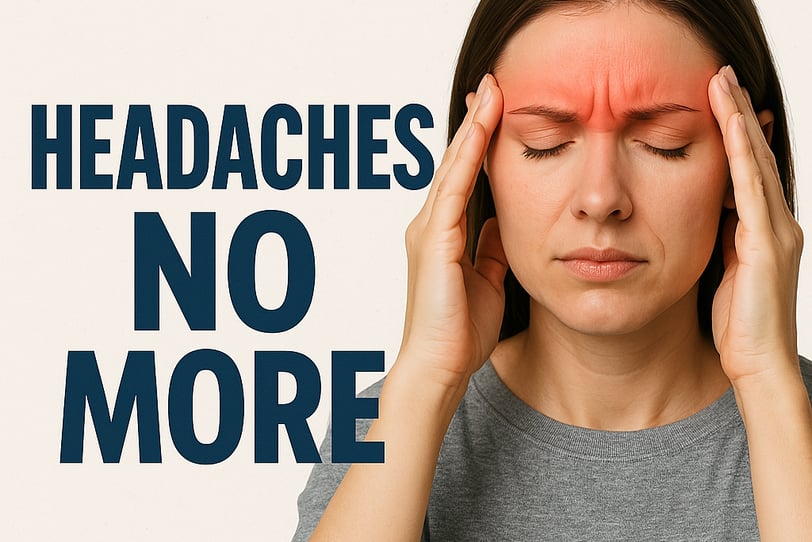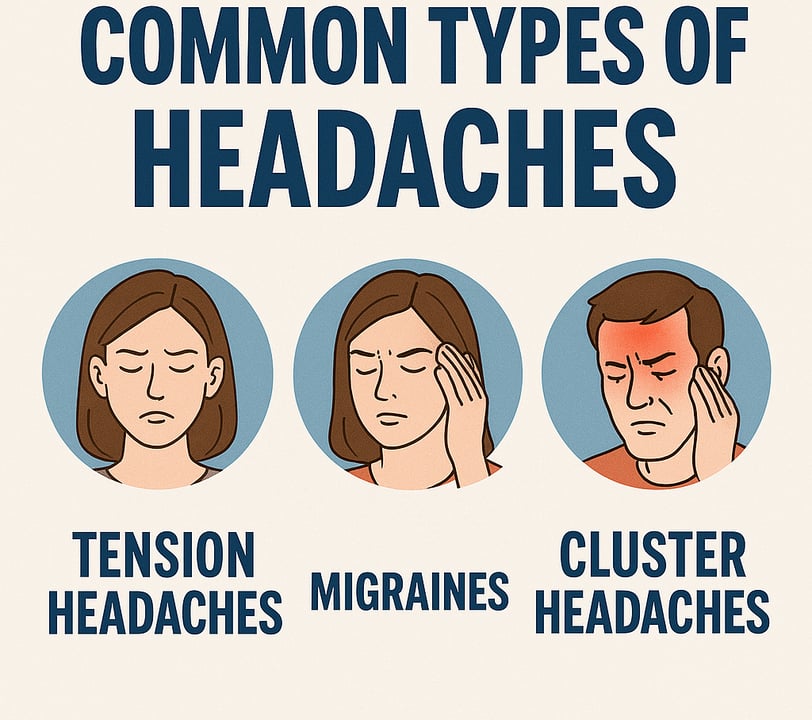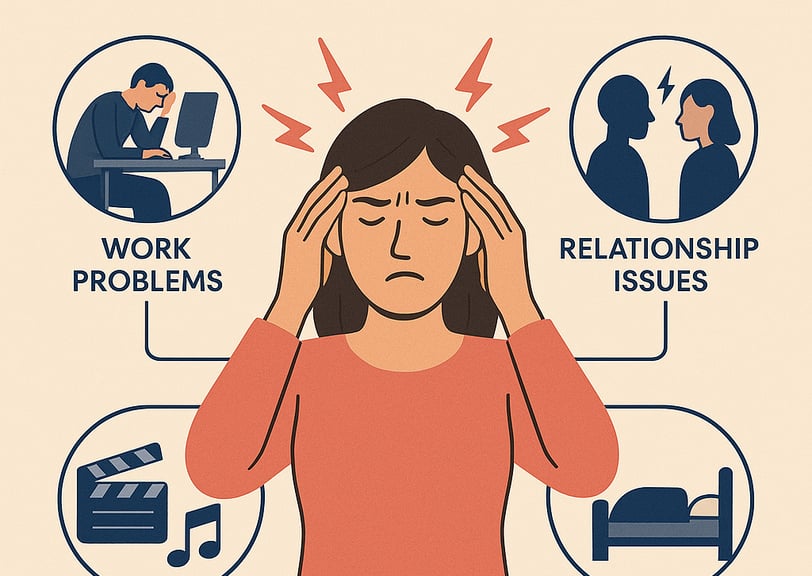Beat the Pain: Effective Solutions for Headache Relief You Should Try!
Headaches are a common yet frustrating part of life, but understanding their causes and effects can help you find the best relief. Whether you’re dealing with tension headaches, migraines, or sinus issues, this comprehensive guide covers everything from triggers to effective solutions. Discover practical tips and natural remedies to ease the pain and take control of your well-being today!
WELLNESS
James B.
4/8/20257 min read
Headaches No More: The Causes, Effects, and Best Ways to Find Relief
We've all been there. The world seems to spin a little too fast, your head feels like it's in a vice, and all you want is relief. Whether it’s a dull throb or a sharp, incapacitating pain, headaches are a common yet debilitating part of life. But what if you could unlock the secrets to headache relief that go beyond just popping a painkiller? Understanding the causes, effects, and the best ways to fight back could make all the difference. Let’s dive into the world of headaches, what causes them, how they affect your body, and most importantly, the most effective solutions that can help you find comfort again.
Understanding Headaches: The Basics
A headache is more than just a simple inconvenience. It’s your body’s way of signaling that something might be off. Though most of us tend to grab over-the-counter medicine or just lie down in a dark room when a headache strikes, understanding the causes of headaches is essential for finding long-term relief. They can range from mild tension headaches to severe migraines, and while they share some symptoms, each type has its unique triggers and solutions.
What Happens During a Headache?
Headaches occur when there is pain in or around the head, often due to an issue with blood vessels, nerves, or muscles. The brain itself doesn’t feel pain, but surrounding tissues and structures do. During a headache, these areas can become inflamed or overstimulated, leading to the uncomfortable sensations we experience.
There are several types of headaches, but let’s look at the main categories to get a clearer picture.
Find fast relief from migraines, tension, and hangovers with the TheraICE Migraine Relief Cap-cooling comfort for your head in a soothing, wearable design. 👉https://amzn.to/41skpm1
Ease migraine pain with MigreLief Original Triple Therapy, featuring Puracol for powerful nutritional support and relief. 👉https://amzn.to/41Kv5h8
Experience migraine relief with Vita Sciences Migravent, packed with Vitamin B2, Magnesium, CoQ10, PA-Free Butterbur, and more for premium, natural support. 👉https://amzn.to/4iuDaMv
Common Types of Headaches
Tension Headaches
The most common type, tension headaches, are often triggered by stress, poor posture, or eye strain. They typically feel like a constant pressure or tightness around your forehead, temples, or the back of your head and neck. These are usually mild to moderate in intensity and can be relieved with simple lifestyle changes or over-the-counter medications.Migraines
Migraines are a bit more complicated. These intense headaches often come with additional symptoms like nausea, vomiting, and sensitivity to light and sound. While the exact cause is unknown, it’s believed that migraines are triggered by a combination of environmental and genetic factors. They tend to last longer than tension headaches, sometimes even several days, and can significantly affect a person’s ability to function.Cluster Headaches
Although rare, cluster headaches are extremely painful and occur in cyclical patterns, hence the name "cluster." These headaches often involve sharp, intense pain around one eye and may be accompanied by other symptoms like a red, teary eye or nasal congestion. They’re more common in men and typically happen at the same time of day.Sinus Headaches
Caused by inflammation in the sinuses due to an infection or allergy, sinus headaches usually involve deep, steady pain in the forehead, cheeks, and around the eyes. They are often accompanied by sinus congestion, a runny nose, or facial swelling.
What Causes Headaches?
Headaches can be triggered by a variety of factors, and pinpointing the exact cause can sometimes be tricky. Below are some of the most common headache triggers:
Stress and Anxiety
One of the leading causes of headaches is stress. When you’re stressed, your muscles tighten, especially around your neck and shoulders, leading to tension headaches. Anxiety can also amplify these headaches, making them feel worse.Dehydration
Believe it or not, something as simple as dehydration can trigger a headache. When your body doesn’t have enough water, it can lead to a reduction in blood volume, causing headaches.Poor Posture
Slouching or sitting in the wrong position for long periods of time can strain the muscles in your neck and back, leading to tension headaches. This is particularly common in those who work long hours at a desk.Diet and Food Triggers
Certain foods like chocolate, caffeine, alcohol, or processed meats can trigger headaches, especially migraines. It’s thought that these foods either dilate blood vessels or cause inflammation, both of which can lead to pain.Hormonal Changes
Many women experience headaches as a result of hormonal changes, particularly around menstruation, pregnancy, or menopause. Migraines are especially common during these times.Sleep Issues
Getting too much or too little sleep can disrupt your body’s natural rhythms and trigger headaches. Sleep disorders like insomnia or sleep apnea are often linked to chronic headaches.Environmental Factors
Changes in the weather, loud noises, bright lights, or strong smells can set off headaches for some people. These environmental triggers often affect those prone to migraines or cluster headaches.
How Headaches Affect Your Life
Headaches, while common, can severely impact your quality of life. Whether it's the occasional tension headache or chronic migraines, the effects of ongoing headaches extend far beyond the physical pain. Here are a few ways headaches can take a toll:
Reduced Productivity and Focus
A headache can make it difficult to focus on work, school, or even simple daily tasks. Chronic headaches or migraines can result in missed workdays, poor performance, and diminished productivity.Impact on Relationships
Persistent headaches can strain relationships. You might find yourself cancelling plans, avoiding social events, or being irritable when pain strikes. This can affect both personal and professional relationships.Mental Health Strain
Constant pain or the fear of a headache coming on can lead to anxiety or depression. Over time, the emotional toll of chronic headaches can be just as debilitating as the physical pain itself.Poor Sleep Quality
If you’re regularly waking up with a headache or having them at night, your sleep quality will suffer. This, in turn, can make your headaches worse, leading to a vicious cycle of pain and fatigue.
Effective Solutions for Headache Relief
Now that we understand the causes and effects of headaches, let’s talk about the relief strategies that can actually make a difference. Whether you’re dealing with an occasional tension headache or a chronic migraine, there are numerous ways to ease the pain and even prevent future headaches.
1. Hydration
As simple as it sounds, dehydration is one of the most common headache triggers. Ensure you’re drinking plenty of water throughout the day. Aim for at least 8 glasses (about 2 liters) of water daily, and consider adding hydrating foods like cucumbers, watermelon, and oranges to your diet.
2. Stress Management
Since stress is a major trigger for headaches, it’s important to manage it in healthy ways. Techniques like deep breathing, listening to calming music, and progressive muscle relaxation can ease tension and help prevent headaches. Staying active—whether through a daily walk, cycling, or even dancing—can also lower stress levels and boost overall wellness.
3. Proper Posture
If your headaches are related to poor posture, adjusting how you sit or stand can make a huge difference. Try to maintain an ergonomic setup at your desk and be mindful of how you hold your body. Taking regular breaks to stretch and relieve tension is also key.
4. Restful Sleep
Good quality sleep can significantly reduce the frequency and intensity of headaches. Stick to a regular sleep schedule, aim for 7-9 hours of rest, and create a calming bedtime routine. If you’re experiencing sleep-related headaches, consider seeing a doctor for potential sleep disorders like sleep apnea.
5. Use of Over-the-Counter Medication
For quick relief from headaches, over-the-counter medications such as ibuprofen, acetaminophen, or aspirin can work wonders. However, they should be used sparingly and not as a long-term solution, as overuse can lead to rebound headaches.
6. Essential Oils and Aromatherapy
Some people find relief from headaches using essential oils like lavender or peppermint. These oils can be applied to the temples or diffused into the air to help soothe headache symptoms. Aromatherapy has been shown to be particularly effective for migraines.
7. Cold or Warm Compress
Applying a cold compress to the forehead or a warm compress to the neck and shoulders can alleviate headache pain. Cold therapy can help reduce inflammation, while warmth can relax tight muscles.
8. Caffeine (In Moderation)
While too much caffeine can trigger headaches, a small amount can actually provide relief for some people. Caffeine constricts blood vessels, which can reduce the pain of a headache. Just be careful not to rely on caffeine too frequently, as it can lead to dependency.
9. Chiropractic Care
Chiropractors can offer relief for tension headaches by adjusting the spine and neck to improve alignment. Regular chiropractic care can help reduce the frequency of tension headaches and migraines for some people.
10. Acupressure
Acupressure, a technique that involves applying pressure to specific points on the body, is gaining popularity as a natural remedy for headache relief. Stimulating pressure points like those on the hands and feet may help alleviate tension and restore balance to the body.
When to Seek Medical Help
While many headaches can be managed at home with lifestyle changes and over-the-counter treatments, some situations require professional help. If you experience any of the following, it’s important to seek medical attention:
Headaches that occur suddenly and severely
Persistent or worsening headaches
Headaches accompanied by vision changes, speech difficulties, or nausea
Headaches following an injury or trauma
Conclusion
Headaches are a frustrating and often painful reality, but they don’t have to control your life. By understanding the causes, effects, and solutions available to you, you can take steps toward effective relief. Whether through hydration, stress management, or a combination of other strategies, there are plenty of ways to tackle headaches head-on. Remember, if your headaches persist or become more severe, it’s always a good idea to reach out to a healthcare professional to rule out any underlying conditions. Take charge of your health, and don’t let headaches hold you back from living your best life!
Find fast relief from migraines, tension, and hangovers with the TheraICE Migraine Relief Cap-cooling comfort for your head in a soothing, wearable design. 👉https://amzn.to/41skpm1
Ease migraine pain with MigreLief Original Triple Therapy, featuring Puracol for powerful nutritional support and relief. 👉https://amzn.to/41Kv5h8
Experience migraine relief with Vita Sciences Migravent, packed with Vitamin B2, Magnesium, CoQ10, PA-Free Butterbur, and more for premium, natural support. 👉https://amzn.to/4iuDaMv







